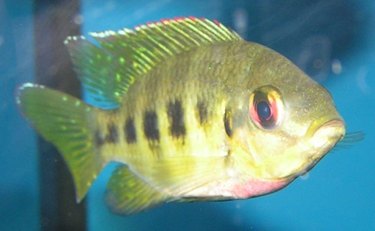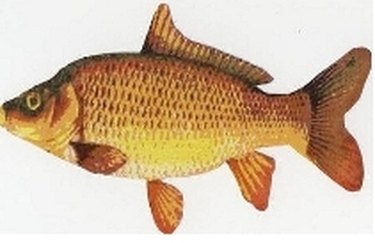
Tilapia belong to an entirely different family of fish than carp. Carp are cyprinids, while tilapia are cichlids. Both fish are omnivorous and cause problems if released into hospitable waters, since they breed prolifically and displace native species. Both carp and tilapia have been farmed successfully for thousands of years and are important commercial species where locally popular. As a food fish, carp has not become accepted in the U.S., but tilapia's flaky and delicious meat has found a ready market.
Carp
Video of the Day

The many varieties of carp include the common carp that is considered a rough or pest fish in most American lakes and rivers, as well as the goldfish and koi that are kept as pets. Carp grow to over 5 feet long and may weigh over 80 pounds. In Europe, carp have become an important sport fish, and in America the interest in them is growing. Originally native to Asia, the carp is now common in Europe and in North America because of intentional release.
Video of the Day
Tilapia
A tropical cichlid, tilapia is native to the Nile River region and has been farmed for food in the Middle East since the time of the Pharaohs. Tilapia have become naturalized in some areas of Florida and are a widespread pest fish in Australia. In Florida, the largest recorded specimen was 15.5 inches long and weighed 3 pounds. Tilapia, like carp, adapt well to poor water conditions and can be easily raised in tanks. Tilapia make poor aquarium pets because of their tendency to root up the tank furnishings and to attack other fish.
Popularity
While carp is a popular food fish in Asia, it finds only a small market in Europe. In the U.S., carp has some importance as an ethnic Asian food. The bony and oily flesh requires special preparation -- American anglers favor species that fillet well, yielding nearly boneless cuts. Tilapia compares well to orange roughy in taste and texture and according to the American Tilapia Association is the fifth most popular food fish in America.
Aquaculture
The growing demand for tilapia has generated commercial interest in tilapia aquaculture in many parts of the U.S. In southern states, where tilapia could be successfully raised in outdoor ponds, there is concern that tilapia might be accidentally introduced to waterways and disrupt native ecosystems. In Australia, tilapia have become so pervasive that control sometimes requires poisoning entire lakes and restocking native fish. In tropical South America, tilapia are already raised in large farming operations and routinely shipped as fillets to American markets.
Potential
Tilapia farming in the United States is one of the fastest growing aspects of the aquaculture industry. As wild stocks of fish decline, tilapia production helps ease pressure on wild fish populations but also presents its own risks to the environment. In Florida, wild tilapia have been partially controlled by the introduction of a second non-native predatory cichlid. Tilapia have also been established in the Salton Sea of California and four lakes in Texas, including Lake Conroe near Houston.